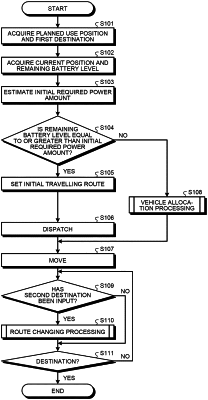| CPC G01C 21/3469 (2013.01) [B60L 58/12 (2019.02); G01C 21/3484 (2013.01); H04L 67/12 (2013.01)] | 9 Claims |

|
1. A server comprising a processor configured to acquire a current position of a moving body used by a user, a remaining battery level of a rechargeable battery of the moving body used by the user, and
a first destination of the user, and in a case where a new second destination different from the first destination is input, set, for the moving body, a charging travelling route passing a charging path capable of charging the battery on a way from the current position to the second destination based on the remaining battery level,
the processor being further configured to:
acquire a planned use position of the user, the first destination of the user, and the remaining battery level,
estimate an initial required power amount of the battery based on the planned use position and the first destination,
determine whether the remaining battery level is equal to or greater than the initial required power amount,
in a case where the remaining battery level is equal to or greater than the initial required power amount, set, for the moving body, an initial travelling route from the planned use position to the first destination, and
in a case where the remaining battery level is less than the initial required power amount, set, for the moving body, an initial charging travelling route passing a charging path capable of charging the battery on a way from the planned use position to the first destination,
determine whether a business type of the first destination is a retail business, in a case where the first destination is a retail business, acquire a purchase history of the user, a behavior history of the user, and inventory information of the first destination,
predict a behavior of the user based on the purchase history, the behavior history, and the inventory information,
estimate a new required power amount of the moving body based on the predicted behavior,
determine whether the remaining battery level satisfies the new required power amount,
in a case where the remaining battery level does not satisfy the new required power amount, set, for the moving body, an initial charging travelling route passing a charging path capable of charging the battery on a way from the planned use position to the first destination, and
output information indicating that the moving body travels on the charging path to the user.
|